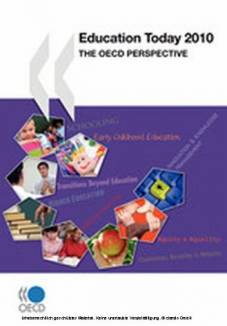|
|
|
Umschlagtext
What does the OECD have to say about the state of education today? What are the main OECD messages on early childhood education, teacher policies and tertiary education? What about student performance, educational spending and equity in education? OECD work on these important education topics and others have been brought together in a single accessible source updating the first edition of Education Today which came out in March 2009.
Organised into eight chapters, this report examines early childhood education, schooling, transitions beyond initial education, higher education, adult learning, outcomes and returns, equity, and innovation. The chapters are structured around key findings and policy directions emerging from recent OECD educational analyses. Each entry highlights the main message in a concise and accessible way, with a brief explanation and reference to the original OECD source. Rezension
Auf welchem Stand ist die Bildung heute? Wie sieht es mit der frühkindlichen Erziehung, Schulpolitik und dem tertiären Bildungsbereich aus? Wie werden Schülerleistungen, Bildungsausgaben und Bildungschancen heute eingeschätzt? "Education Today. The OECD Perspective 2010" fasst diese und andere wichtige Aspekte aus dem Bildungsbereich in einer einzigen, gut verständlichen Publikation zusammen. Der Bericht untersucht die frühe Kindheit, schulische Ausbildung und die Übergänge über die Primärausbildung hinaus. Er befasst sich mit Hochschulbildung, Erwachsenenbildung, lebenslangem Lernen, Bildungsergebnissen sowie Bildungszugang und dem Wissensmanagement.
Oliver Neumann, lehrerbibliothek.de Inhaltsverzeichnis
Foreword 5
Table of Contents 7 Note on Country Coverage and Levels of Education 9 Introduction 11 Chapter 1 – Early Childhood Education and Care 13 INTRODUCTION 14 KEY FINDINGS 14 Figure 1.1.Most children come into education well before the age of 5 years (2008) 15 POLICY DIRECTIONS 16 References 18 Chapter 2 - Schooling – Investments, Organisation and Learners 19 INTRODUCTION 20 KEY FINDINGS 20 Figure 2.1.Average class size in educational institutions, by level of education (2008) 21 Figure 2.2.Total number of intended instruction hours in public institutions between the ages of 7 and 14 (2008) 23 POLICY DIRECTIONS 26 References 29 Chapter 3 - Transitions Beyond Initial Education 31 INTRODUCTION 32 KEY FINDINGS 32 Figure 3.1.Completion of upper secondary education is now the norm across OECD countries (2008) 34 Box 3.1. Youth and economic crisis 35 POLICY DIRECTIONS 37 References 39 Chapter 4 - Higher Education 41 INTRODUCTION 42 KEY FINDINGS 42 Figure 4.1.Population that has attained tertiary education (2008) 43 Figure 4.2.Distribution of foreign students in tertiary education, by country of destination (2008) 45 POLICY DIRECTIONS 45 References 49 Chapter 5 - Lifelong Learning and Adults 51 INTRODUCTION 52 KEY FINDINGS 52 Figure 5.1.Participation in formal and/or non-formal education, by adults aged 25-64 years-old and educational attainment (2007) 53 POLICY DIRECTIONS 54 References 57 Chapter 6 - Outcomes, Benefits and Returns 59 INTRODUCTION 60 KEY FINDINGS 60 Figure 6.1.The spread of student pro ciency levels in science in OECD countries (2006) 61 Figure 6.2.The spread of student pro ciency levels in mathematics in OECD countries (2006) 61 Figure 6.3.The spread of student pro ciency levels in reading in OECD countries (2006) 62 Figure 6.4.Relative earnings from employment, by level of educational attainment and gender for 25-64 year-olds (2008 or latest year available) 64 POLICY DIRECTIONS 66 References 68 Chapter 7 – Equity and Equality of Opportunity 69 INTRODUCTION 70 KEY FINDINGS 70 Figure 7.1.Women have overtaken men in upper secondary and higher education: Attainments of di erent adult age groups, 2008 71 Figure 7.2.Proportion of 20-24 year-olds who are not in education and have not attained upper secondary education, by migrant status (2007) 73 POLICY DIRECTIONS 75 References 79 Chapter 8 - Innovation and Knowledge Management 81 INTRODUCTION 82 KEY FINDINGS 82 Box 8.1. Innovation in Education 83 POLICY DIRECTIONS 85 |

 Bei Amazon kaufen
Bei Amazon kaufen